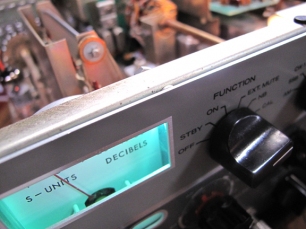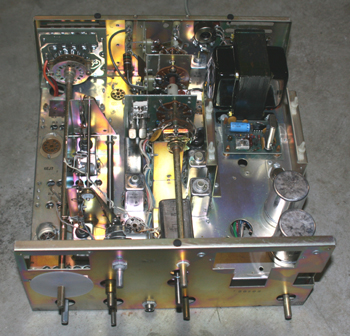.: Drake R4C Restoration
My Drake
R4C
Restoration

In February of 2010 I answered a
Portland area Craig's List ad for "HAM RADIO GEAR, $600 OBO. In the ad was a
very fuzzy picture of a stack of Drake equipment. I have always wanted to have a
C line to create my vintage "boat anchor" station, and this was my chance. I was
the first responder to the ad, which it turns out was a PAIR of Drake C lines
(R4-C, TX4-C, MS-4 with PS-4 installed), a Kenwood TS-830S, a Kenwood AT-230
antenna tuner, a Heathkit GR-64 General Coverage Receiver, and box of "stuff",
most of which ended up in the garbage. The radios had come from the estate of a
ham in in Olympia, Washington, and had been sitting in the daughter's Portland
area garage until she had the courage to part with some of her father's
belongings. Everything was dirty and dusty with slight tinges of rust, but it
was all there.
The Resurrection of a R-4C
Which to start with? Both R-4Cs were
in the later and more desirable serial number range, 21xxx (1973 vintage) and 26xxx (1976 vintage).
The 26xxx radio was newer but very dirty and bone stock, with a bit of minor
rust spots on the chassis, while the 21xxx unit was cleaner (no rust) and
(Surprise!) had
all the factory goodies installed!. This included ALL of the accessory filters
(including the 6 KHz AM filter), NB-4 noise blanker, and a whole bunch of extra band
crystals. On the down side, the older unit looked like it was well used
and worn, both inside and out. I slowly fired up the
receivers using a variac to re-vitalize the electrolytic caps and found out that both
radios "kind of" worked. Cleaning the switch contacts
made a world of difference, but the later unit came to life and was receiving
signals first. I decided to restore that radio as it was the later serial number, and appeared to have had much less wear and tear on it over the years. The
other would donate its accessory goodies for the common good.
Time to clean things up a bit! I started by completely
dismantling the R-4C's faceplate, removed the tubes and band crystals, then removed the PTO assembly
to keep water out of it. This was followed by a trip
though the dishwasher (set to delicate, of course!). Here is a picture of the
washed chassis, sans tubes, PTO, filters, crystals, and noise blanker. What a
difference a few minutes made!:

After a week of dry time, I
sanded the rusty parts of the chassis with 600 grit sandpaper (mostly along the
bottom edges), then sprayed the affected areas with clear Krylon paint. After
that dried, I re-installed the PTO (after a cleaning of the gears and some
teflon lube), checked and reinstalled the tubes and band crystals, then
proceeded to rob the other R4-C of its AM
filter, three accessory filters (1.5 KHz SSB, 500 and 250 Hz CW), and the Noise
Blanker. Believe it or not, it all worked when it was put together, (except for a
nasty bacon frying noise from the 3rd mixer...). OK, there is a fix for that!
Time to get on the phone with Rob
Sherwood of Sherwood Engineering to
get all the mods that make the R-4C sing like a modern radio! About $130 later I
had the
new audio amp board (AMP-4), new product detector (PD-4), new power supply board
(PS-4) and the new solid state 3rd mixer board (MIX-4), which replaced the 6EJ7
3rd mixer tube and eliminated the bacon frying pan noise the radio had. All
were very easy to install on a rainy Sunday afternoon, thanks to the great
detailed color instructions provided by Sherwood in the
kits. I also replaced the dial lamps with blue LED versions, purchased from a
supplier on E-Bay.
Were the mods worth it? YOU BET. They made a world of
difference in how the radio performed! I would rate the modified R-4C's sensitivity at least as
good as my modern Yaesu FT-2000, maybe with an even quieter background noise
level. I have not gone to the point of installing the extra Inrad GUF-1 filtering to this radio since it is not going to be used for
anything serious,
just occasional nostalgia QSOs. Here is a picture of the "leftover parts" after the
Sherwood boards were installed:

Next job, repair the matching TX4C, which has a PTO that
is off frequency.....
ntennas.
|
|
.:
|




